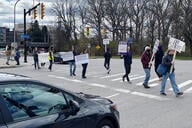You have /5 articles left.
Sign up for a free account or log in.
Faculty members at the University of Pittsburgh said this week that they’d voted to form a union affiliated with the United Steelworkers. The vote was 1,511 in favor and 612 opposed, according to the Pennsylvania Labor Relations Board, which counted the mail-in ballots.
The 3,355-person bargaining unit includes all full- and regular part-time tenured, tenure-track and non-tenure-track professors and librarians across all Pitt campuses, excluding the School of Medicine. It’s one of the biggest unions to form this year in the U.S., in any sector.
Once certified, the unit will also be the biggest new faculty union formed in a decade, according to information from the National Center for the Study of Collective Bargaining in Higher Education and the Professions at Hunter College of the City University of New York.
The road to unionization was long, even by labor organizing standards. Paul Johnson, an assistant professor of communication who has been on the union organizing committee since 2015, said that even with thousands of members, “In order to build a really, truly inclusive and democratic union, you’ve got to talk to basically all of those people. We weren’t going to run a campaign where we didn’t have a sense that a strong majority of the faculty were going to be supportive and where we didn’t have a sense of what people’s issues, needs, wants and concerns were.”
In addition to all this groundwork, organizers butted heads at times with the university, including over who would be included in the unit. The state labor board eventually sided with the union in 2020, finding that the university supplied a “factually and legally inaccurate” list of potential unit members. Organizers contended that Pitt was deliberately trying to stack names to make it harder for them to gather enough signatures -- 30 percent of the potential unit -- to trigger a union election. Pitt also hired a legal firm, Ballard Spahr, to advise it on the faculty union drive, as well as on a union drive among graduate students that the PLRB deemed unsuccessful earlier this month (that would-be union fell 39 votes short in a separate election).
Johnson said he joined the faculty union drive in part to help preserve his good health-care coverage, and his ability to pay for it, as his health-care premium increase exceeded his cost-of-living increase this year. He said he also felt that his research on national populism makes him a potential target for harassment or retaliation, and that a union could be more effective than existing governance structures in protecting him from backlash.
When he was talking to colleagues about unionization, shared governance concerns surfaced again and again, Johnson also said. “Our organs for faculty representation are sort of toothless, more procedural than substantive. And these are connected to other issues of transparency and decision making, like not knowing sometimes why budgetary decisions are being made,” including COVID-19-related cuts.
Lack of childcare options and other caregiving concerns also went from “already a big deal to a five-alarm fire” during the pandemic, Johnson said.
Melinda Ciccocioppo, a full-time lecturer in psychology at Pitt who also helped organize for the union, said that “transparency and pay” are among professors’ top concerns, with pay perhaps being a bigger priority for non-tenure-track professors. Ciccocioppo said she worked as an adjunct at Pitt and other institutions before getting her full-time job, and she was lucky before to make $20,000 per year teaching five courses per semester. Even now, she said she makes about half of what her tenure-stream colleagues make.
Other key issues for the union going into contract negotiations are job security, including for adjuncts, who must reapply for their jobs each term; stronger due process protections; clear workload expectations for service and other responsibilities; fair evaluation procedures for non-tenure-track instructors; research and teaching support; academic freedom assurances; and intellectual property and civil rights.
Pitt said in a statement, “From the outset, the university did not take a position on how faculty should vote, and urged maximal participation in this important decision. We have always maintained that this is a faculty matter and a faculty decision and are evaluating next steps.”
While the formation of a faculty union “may change how our community works together,” Pitt said, “it will not change our longstanding commitment to partnering with faculty members to advance their pursuits of excellence in teaching, scholarship and research.”
Ciccocioppo said that she hopes the creation of a union will make Pitt a better place generally, not just for the faculty.
“I hope this will lead to us sitting down and really being able to find some common ground and creative solutions for the problems that we see facing this institution,” she said. “That’s really what we’ve been fighting for this whole time.”
Other research institutions with relatively new faculty collective bargaining relationships are the University of New Mexico, the University of Oregon and Oregon State University, said Bill Herbert, executive director of the National Center at Hunter College.
At least at Pitt, Johnson said it always made sense to include all faculty ranks in the unit. “There were lots of people at lots of different ranks who said, ‘You know, we’re not having a good time at work, things need to change,’ or who saw things happening to their colleagues who have less authority, less power, less resources in the institution and said, ‘This is something that needs to change.’ … There’s no way for the university to work if we’re not all working together.”
Pitt and Pennsylvania State University were the only public institutions in the state without a faculty union prior to the Pitt election, according to the USW.





